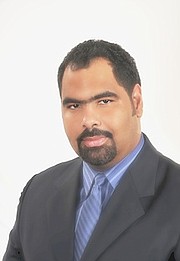By NEIL HARTNELL
Tribune Business Editor
nhartnell@tribunemedia.net
Fidelity Bank (Bahamas) shareholders will next Friday receive an early Christmas present through a total $16.45m dividend payout by the BISX-listed institution.
Gowon Bowe, Fidelity’s chief financial officer, confirmed that some $8.949m of the capital return is based on the commercial bank’s normal profitability, while the $7.5m balance represents the profit earned on selling its 50 percent ownership in former merchant banking affiliate, RoyalFidelity.
“We said whatever profit we made on that we would give back to the shareholders, and not deploy into other resources,” he explained, revealing that Fidelity Bank (Bahamas) typically tries to return 70 percent of its annual net income to shareholders in the form of dividends.
That ratio will this year be boosted by the long-promised proceeds from the RoyalFidelity disposal. While the majority, some 75 percent, will be claimed by the commercial bank’s ultimate parent, Fidelity Bank & Trust International, the retail investors and institutions that make up the 25 percent minority will at least have more than $4.11m to cheer about.
Both the 31 cents per share regular dividend, and 26 cents per share extraordinary dividend, are due to be paid out on December 13 to shareholders of record as at Wednesday, December 11. Thus the total payout will be equivalent to 57 cents per share.
Mr Bowe revealed that Fidelity Bank (Bahamas) is “tracking” for a full-year 2019 profit, meaning that ordinary capital returns to shareholders will be around $17.5m in total. Adding in the RoyalFidelity dividend takes that to near $25m.
“I think what we are mindful of certainly is there’s a balance between returning capital to be deployed and returning capital to shareholders,” the Fidelity Bank (Bahamas) chief financial officer explained.
“The lending market is not expanding, and there are a number of headwinds facing the industry. We didn’t have fantastic lending conditions before the hurricane, and subsequently knew there would be some challenging events even though I don’t believe the economy’s prospects are as dim as people project.
“Holding that $7.5m in extra equity, we don’t have useful resources to deploy it into. If you’re not expanding the loan portfolio it has to be held in cash deposits that are paying little to no interest or invested in fixed income securities which are not our primary business.”
Mr Bowe argued that the wisest “investment decision” was thus to return the full $7.5m to shareholders as a reward for the risk taken. He added that, even after the dividends were paid, Fidelity Bank (Bahamas) will have a risk-weighted capital ratio of more than 21 percent - well ahead of the 17 percent minimum set by the Central Bank.
“There’s no need to retain any more capital,” he said. “We have significant headroom to sustain any unforeseen circumstances that reduce profitability or cause unforeseen circumstances for the institution.”
Mr Bowe added that the BISX-listed bank always deployed capital in a manner to keep it within its 20-25 percent return on shareholders’ equity target range. “That means we have to balance between ensuring we’re not over-capitalised as it then becomes difficult to earn a return,” he explained.
“We remain true to our underlying principles, and ensure the return is commensurate with the risk taken, and that is between a 20-25 percent return on equity.”
The Fidelity Bank (Bahamas) chief financial officer said the commercial lender was on target to achieve its goal of a 10-12 percent year-over-year increase in organic profitability - a measure that strips out the one-off gains from the RoyalFidelity deal.





Comments
Use the comment form below to begin a discussion about this content.
Sign in to comment
OpenID